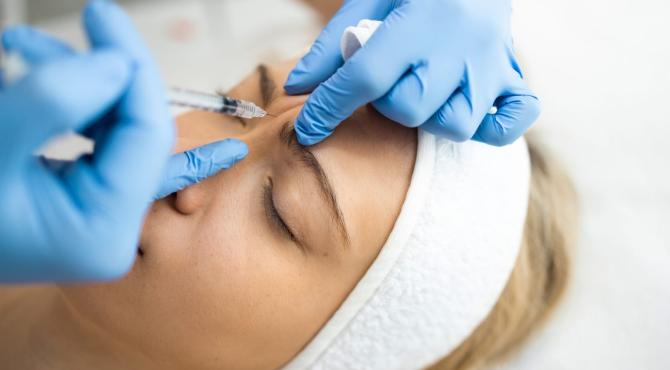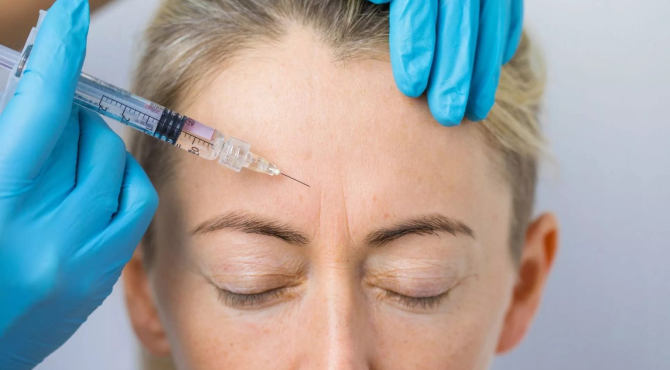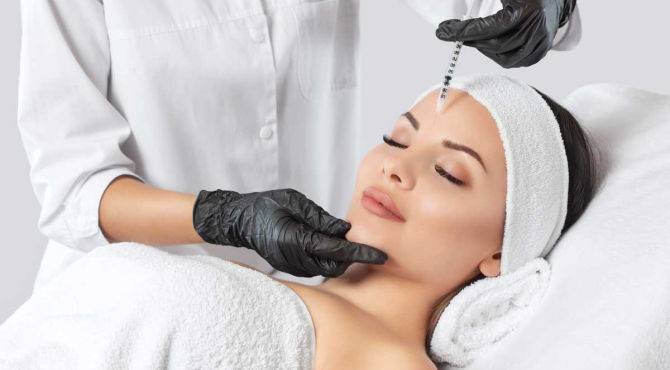Botuliinihoito eli Botox

Botox on yksi suosituimmista ja turvallisimmista tavoista hoitaa ryppyjä, kasvojen väsynyttä ilmettä ja ikääntymisen merkkejä.
Tarjoamamme botuliinihoito palauttaa kasvojen luonnollisen raikkauden ja nuorekkuuden ilman liiallista volyymia tai invasiivisia toimenpiteitä. Lopputuloksena on huoliteltu ilme, jossa kasvonilmeet säilyvät luonnollisina - ilman jäykkyyttä.
Mikä on Botox?
Botox on pistettävä lääkevalmiste, joka rentouttaa ryppyjä aiheuttavia lihaksia. Sitä käytetään yleisesti otsaryppyjen, sibeliusryppyjen, silmäkulmien juonteiden ja muiden ilmejuonteiden hoitoon.
Käytämme klinikallamme Allerganin alkuperäistä, sertifioitua Botox-valmistetta varmistaaksemme hoidon turvallisuuden ja pitkäkestoiset tulokset. Valmiste sisältää puhdistettua botuliinitoksiini A:ta, jota annostellaan mikromäärinä ilman riskiä kehon yleiselle terveydelle.
Botuliini vaikuttaa paikallisesti vain pistosalueella, eikä sillä ole vaikutusta kehon yleiseen hyvinvointiin.
Mitä ongelmia voidaan hoitaa Botoxilla?
- Otsarypyt
- Kulmakarvojen välinen Sibelius juonne (ts. Sibelius-ryppy)
- Silmäkulmien rypyt (ts. ”harakanvarpaat”)
- Alakasvojen ja kaulan alueen juonteet (Nefertiti lift)
- Marionettijuonteet
- Bruksismi eli yöllinen hampaiden pureminen
- Liikahikoilu (hyperhidroosi kämmennissä ja kainaloissa)
- Liian näkyvä ikenien paljastuminen hymyillessä (ts. "gummy smile")
- Kireä/ jännittynyt leuka
- Kapeat huulet ja ylähuulen muotoilu (lip flip)
- Nenän muodon hienovarainen korjaus (siipien kavennus, kärjen kohotus)
Missä muualla Botoxia voidaan käyttää?
Botox tunnetaan laajalti tehokkaana keinona ryppyjen silottamiseen ja kasvojen nuorentamiseen. Sen käyttö ei kuitenkaan rajoitu vain esteettisiin hoitoihin – botuliinitoksiinia on hyödynnetty lääketieteellisessä hoidossa jo yli 20 vuoden ajan.
Miksi tällä on merkitystä?
Botox ei ole pelkkä kauneustuote, vaan tieteellisesti tutkittu ja lääkinnällisesti hyväksytty valmiste. Se on saanut hyväksynnän FDA:lta ja useilta kansainvälisiltä terveysviranomaisilta, ja sitä käytetään myös vaativilla lääketieteen osa-alueilla. Tämä vahvistaa sen luotettavuuden ja turvallisuuden myös esteettisissä hoidoissa.
Minkä ikäisenä voi aloittaa Botoxin käytön?
Botox-hoitoa suositellaan yleensä aloitettavaksi noin 25–30 vuoden iässä, kun ensimmäiset ilmejuonteet alkavat näkyä. Tässä vaiheessa hoitoa käytetään usein ennaltaehkäisevästi estämään ryppyjen syvenemistä.
Ikäraja ei kuitenkaan ole ehdoton. Yksilölliset tekijät, kuten kasvojen ilmeikkyys, perinnöllinen taipumus ja ihon laatu, vaikuttavat siihen, milloin hoito on ajankohtainen. Joillekin botuliinihoito voi olla perusteltu jo aiemmin, esimerkiksi voimakkaiden ilmeiden tai liikahikoilun (hyperhidroosi) vuoksi.
Päätös hoidon aloittamisesta tehdään aina yhdessä lääkärin kanssa ihon kunnon ja tarpeiden perusteella.
Kuinka kauan Botoxin vaikutus kestää?
Botoxin vaikutus kestää yleensä noin 3–6 kuukautta. Säännöllisesti tehtynä hoito auttaa ylläpitämään raikkaan ja levänneen ilmeen sekä hidastaa uusien juonteiden muodostumista.
Sopiiko Botox kaikille?
Botox ei sovellu kaikille. Hoitoa ei suositella raskauden tai imetyksen aikana, eikä sitä käytetä henkilöillä, joilla on tietyntyyppisiä lihas- tai autoimmuunisairauksia, akuutti infektio tai allergia botuliinin ainesosille.
Voiko Botoxin ja täyteaineet yhdistää 40 ikävuoden jälkeen?
Kyllä. Yli 40-vuotiaana rypyt voivat olla syvempiä, jolloin pelkkä Botox ei aina riitä halutun lopputuloksen saavuttamiseen. Hoito aloitetaan usein lihaksia rentouttavalla Botoxilla, ja tarvittaessa sitä täydennetään täyteaineilla tai muilla tukevilla hoitomuodoilla, kuten mikroneulauksella (RF), kirkastavalla RF-hoidolla, biorevitalisaatiolla tai pigmenttimuutoksia vaalentavilla hoidoilla.
LIP FLIP
Lip Flip on luonnollinen tapa korostaa huulia ilman volyymin lisäämistä. Kyseessä on nopea ja hellävarainen pistoshoito, jossa käytetään botuliinitoksiinia suun ympärillä olevien lihasten rentouttamiseen. Tämän vaikutuksesta ylähuuli kääntyy kevyesti ulospäin ja näyttää visuaalisesti täyteläisemmältä – täysin ilman täyteaineita.
Kenelle Lip Flip sopii?
- Henkilöille, joilla ylähuuli katoaa tai nousee liikaa hymyillessä
- Niille, jotka haluavat korostaa ylähuulta ilman volyymin lisäämistä
- Heille, jotka etsivät kevyttä ja luonnollista tapaa muotoilla huulia ilman täyteaineita
Miten tekniikka toimii?
Erikoislääkäri tekee 2–4 pientä pistosta ylähuulen yläpuolelle, käyttäen erittäin pieniä määriä botuliinitoksiinia. Tämä rentouttaa huulta liikuttavaa lihasta kevyesti, jolloin ylähuuli kohoaa hieman ja näyttää luonnollisen täyteläiseltä.
Milloin tulos näkyy ja kuinka kauan se kestää?
Ensimmäiset tulokset näkyvät 3–5 päivän kuluttua. Vaikutus kestää keskimäärin 6–8 viikkoa, ja hoito voidaan toistaa säännöllisesti tuloksen ylläpitämiseksi.

Bruksismin hoito Botoxilla
Kärsitkö leuan jännityksestä, hampaiden kiristelystä tai toistuvista päänsäryistä? Kyseessä voi olla bruksismi, ja siihen on olemassa tehokas hoitomuoto: Botox.
Bruksismi on tahatonta leukojen puremista tai hampaiden narskuttelua, joka esiintyy useimmiten unessa. Taustalla voi olla stressi, purentahäiriöt, lisääntynyt lihasjännitys tai unihäiriöt.
Mitkä ovat bruksismin oireet?
- Yöllinen hampaiden narskuttelu (yleensä läheiset huomaavat)
- Leuan jännittyneisyys ja arkuus aamulla
- Päänsärky, erityisesti ohimoiden alueella
- Purentalihasten kasvanut koko
- Purennan muutokset
- Naksuminen tai kipu suuta avatessa
Miten Botox auttaa?
Botuliinitoksiinipistokset purentalihaksiin vähentävät lihasten liiallista jännitystä. Lihakset rentoutuvat hallitusti ilman, että kasvojen ilmeet, puhe tai pureskelu häiriintyvät.
Hoidon jälkeen saat:
- Rennon ja kivuttoman leuan
- Lievitystä päänsäryyn ja lihasjännitykseen
- Suojaa hampaille kulumista vastaan
- Pehmeämmät ja tasapainoisemmat kasvonpiirteet
Tulokset näkyvät 3–7 päivän kuluttua ja kestävät jopa 6 kuukautta.
Voiko bruksismista päästä pysyvästi eroon?
Botox hoitaa tehokkaasti bruksismin lihasperäisen syyn. Pysyvämmän ja pitkäkestoisemman tuloksen saavuttamiseksi suosittelemme yhdistämään hoitoon purentafysioterapian, uniterapian sekä stressinhallintakeinoja.
Vaikuttaako Botox kasvojen muotoon?
Kyllä – positiivisesti. Lihasjännityksen väheneminen pienentää purentalihasten kokoa, mikä pehmentää kasvonpiirteitä ja tekee ilmeestä tasapainoisemman ja symmetrisemmän.
Nefertiti Lift
Botox-injektiot kasvojen ja kaulan alempaan kolmannekseen
Toimenpide on saanut nimensä egyptiläiseltä kuningatar Nefertitiltä, joka tunnettiin sirosta profiilistaan ja selkeistä kasvonpiirteistään. Hänen kauneutensa on inspiroinut tekniikkaa, jonka avulla kasvojen ja kaulan nuorekkuus sekä linjakkuus voidaan palauttaa ilman kirurgisia toimenpiteitä.
Nefertiti lift:
- Kiinteyttää kasvojen soikion
- Tasoittaa kaulan juonteita
- Vähentää ihon veltostumista ja epätasaisuutta
- Virkistää leukalinjan aluetta
- Kohottaa laskeutuneita suupieliä
Vaikutus syntyy rentouttamalla platysma-lihasta – ohutta kaulalihasta, joka iän myötä vetää kudoksia alaspäin. Botoxin avulla kasvojen piirteet näyttävät kiinteämmiltä ja ääriviivat selkeämmiltä, lähes kuin Nefertitillä itsellään.
Toimenpide kestää noin 20 minuuttia, eikä se aiheuta juuri lainkaan epämukavuutta.
Mielenkiintoinen fakta!
Tekniikka on erityisen suosittu näyttelijöiden, tv-juontajien ja julkisuuden henkilöiden keskuudessa, jotka tarvitsevat ilmeikkään profiilin kameran edessä. Tulokset kestävät 4-6 kuukautta, ja ilmeet säilyvät luonnolisina ja eloisina.
Botuliinihoito liialliseen hikoiluun
Liikahikoilu (hyperhidroosi) ei ole vain epämukavaa, vaan myös heikentää merkittävästi elämänlaatua. Jos antiperspirantit eivät enää auta, botuliinitoksiini-injektiot (kuten Botox tai Dysport) tarjoavat turvallisen ja tehokkaan ratkaisun.
Mitä tuloksia voit odottaa?
- Hikoilu vähenee jopa 100 %
- Vaikutus alkaa 3-7 päivän kuluessa
- Tulos kestää 6-12 kuukautta
- Kivuton toimenpide ilman toipumisaikaa
Missä tilanteissa botuliinihoito auttaa?
- Kainaloiden, kämmenten, jalkapohjien, kasvojen tai selän liikahikoilu
- Epämukavuus lämpimissä olosuhteissa
- Runsas julkinen esiintyminen
- Halu tuntea olonsa varmaksi kaikissa tilanteissa
Miten toimenpide etenee?
Hoidossa käydään ensin läpi lääkärin konsultaatio ja tehdään tarvittava arvio liikahikoilun alueesta. Tarvittaessa käytetään paikallispuudutusta ennen botuliinipistoksia. Koko toimenpide kestää noin 20–30 minuuttia, ja sen jälkeen voit palata normaalisti päivittäisiin askareisiin.

Ientaskuhymyn korjaus Botoxilla
Ienhymy tarkoittaa tilannetta, jossa hymyillessä ikenet paljastuvat yli 2–3 mm. Yleisin syy on ylähuulen nostolihasten yliaktiivisuus, jota voidaan hoitaa tehokkaasti botuliinipistoksilla.
Botox auttaa:
- Tekemään hymystä harmonisemman
- Säilyttämään luonnolliset ilmeet
- Saavuttamaan tuloksia 3–5 päivässä
- Saavuttamaan jopa 4–6 kuukauden vaikutuksen
- Ilman kipua tai toipumisaikaa
Toimenpiteen hyödyt:
- Nopea ja turvallinen hoito
- Sopii sekä miehille että naisille
- Ei vaikuta puheeseen tai ilmaisukykyyn
MESQ®
DoctusPlus Oy:n aputoiminimi
Yritys
DoctusPlus Oy
Y-tunnus
3154088-6
Käyntiosoite
Itämerenkatu 11-13 F, 00180 Helsinki
Puhelin
Sähköposti
Aukioloajat
Ma – Pe 11:00 – 19:00